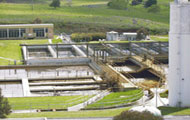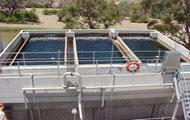Sewerage and Water Filtration
Before the introduction of a sewerage system in Orange the 'Sanitary Man' or better known as the 'San Man', 'Night Cart' or 'Dunny Man' would travel along purpose-built lanes at the back of houses during the night. This was probably performed with a horse and cart and each can exchanged for a fresh one.
The excavation of trenches and laying of pipes for a sewerage system began in 1915 with 16 miles of cement pipe laid. The ingenuity of the government engineers saw the mains follow the natural slope of Blackman's Swamp Creek to the new treatment works located nearly 2 miles away. Manholes were laid every 4 chains to allow for the clearing of blockages.
The Orange Waste Water Treatment Plant was commissioned in 1919 and has had numerous upgrades to the present standard valued at $30,000,000.00. In 1990 a second smaller plant was constructed north of the village of Spring Hill to service the villages of Spring Hill and Lucknow.
Approximately 75% of treated effluent from the Orange Waste Water Treatment Plant is exported to the Cadia Valley Operations Re-use Scheme for use in the ore extraction process and is a valuable water source for the gold mine. The remaining 25% is discharged to the nearby Blackman's Swamp Creek.
There are two main filtration plants to service Orange's water supply, the Icely Road filtration plant and the Spring Creek Filtration Plant. Water from each dam is pumped to the plant and treated before being pumped to a service tank that is then gravity fed into the reticulation process. It is proposed upgrade work will commence on Spring Creek Dam prior to Christmas.
In 2001, Council commissioned the first Ozone/Biological Activated Carbon (BAC) water treatment plant in New South Wales. This project has solved the problem of taste and odour associated with the persistent blooms of blue-green algae in Suma Park Dam. Detailed design work is currently underway for Suma Park Dam wall raising, increasing its capacity by approximately 12%.

View Caption
